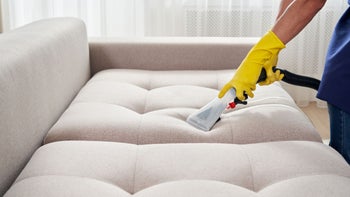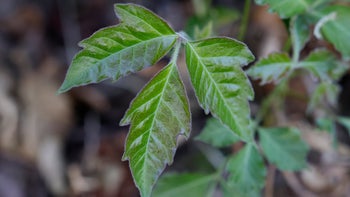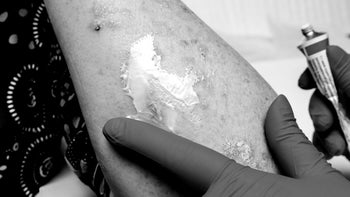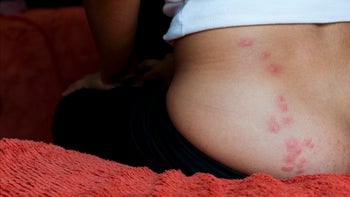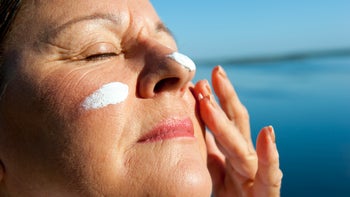
13 Essentials to Keep in Your First-Aid Kit (and Some Extras for Summer)
Key takeaways:
You can easily build your own first-aid kit to be prepared for most emergencies, including cuts, burns, sprains, and more.
A first-aid kit for summer can also include aloe vera gel for sunburns, numbing spray or cream to treat insect bites, and extra water to treat dehydration.
After you add basic first-aid supplies, customize your kit by including emergency contact information, personal medications, and medical information about family members.

Have you ever found yourself with a bleeding injury and suddenly realized you’re out of bandages? A quick run to the pharmacy is never fun in the midst of an urgent situation. That’s when a first-aid kit comes to the rescue.
First-aid kits can be even more important in the summer when people spend more time outdoors and tend to be more active, making them more at risk for injuries.
To be ready for life’s unexpected scrapes and bumps, here are your lucky 13 essentials to keep in your first-aid kit.
Search and compare options
1. Band-Aids
It’s best to have a variety of sizes. The Red Cross recommends including about 25 Band-Aids (adhesive bandages). Keep in mind that although latex bandages attach well to the skin, some people are sensitive to latex. So you might want to include some latex-free Band-Aids as well.
2. Gauze pads
Here it also helps to have a few different sizes. Ideally you have a mix of 2-by-2 inch gauze pads and 4-by-4 inch gauze pads. Consider adding in a few nonstick gauze pads to use in case of burns.
3. Adhesive cloth tape
This is helpful for attaching gauze pads to the skin and creating a proper dressing. A 1-inch width is a good size for a first-aid kit.
4. Scissors
A small pair of scissors will help you cut dressings down to the right size. They’ll also help cut cloth tape and open packages.
5. Elastic bandages
You can wrap elastic bandages around an area of muscle strain, such as an ankle sprain. They can also be used to wrap around a Band-Aid or dressing so that a younger child doesn’t try to remove it.
6. Alcohol wipes
Alcohol wipes are great for sterilizing equipment (like tweezers) or keeping a makeshift first-aid station clear of germs. But don’t use them to clean a wound. The alcohol can actually harm the tissue and delay healing in open wounds.
Read more like this
Explore these related articles, suggested for readers like you.
The best way to clean an open wound is to use mildly warm and soapy water, or let clean water run over the wound for several minutes. If you’re out somewhere without access to clean water, you can use alcohol swabs to sterilize the wound. But be warned, it will sting!
7. Antibacterial ointment or cream
According to Anjali Bharati, DO, emergency room physician with Northwell Health in New York, a topical antibiotic ointment or cream can be helpful in preventing wound infections — once a wound has been cleaned thoroughly. But, she cautions, “not every wound requires antibiotic ointment.” Cleaning a wound thoroughly — and keeping it clean — is usually enough to prevent infection.
8. Gloves
Include two pairs of non-latex gloves. Large-sized gloves are generally best. Consider including two different sizes, depending on the size of the person most likely to use the first-aid kit.
9. Thermometer
A thermometer can be helpful to figure out if someone has an infection or a heat-related illness. Avoid glass thermometers since they can shatter. If it’s battery-operated, make sure to include batteries.
10. Hydrocortisone ointment
Hydrocortisone cream or ointment can be helpful to treat a variety of rashes, from bug bites and poison ivy to allergic skin reactions (contact dermatitis).
11. Tweezers
Tweezers can help you remove splinters, ticks, or insect stingers. Stainless-steel tweezers (not plastic) are best since they’re durable and easy to sterilize.
Some people like to have a couple different types. Tweezers with a slanted tip are best for removing splinters, while tweezers with a pointed tip are best for removing ticks.
12. First-aid instructions
The Red Cross has a compact first-aid reference guide with emergency care guidance for situations like choking, heart attacks, strokes, allergic reactions, and burns. This doesn’t replace CPR and first-aid training, but a reference guide can help make sure you know what to do in a true emergency.
13. Medications
Include some basic medications to help in emergency situations:
Pain relievers: Acetaminophen (Tylenol) or ibuprofen (Advil) can help ease pain. Include a liquid version for kids, too.
Antihistamines: Medications like diphenhydramine (Benadryl) can help with allergic reactions.
Aspirin: This can be lifesaving in cases of a suspected heart attack. If someone has new or unexplained chest pain or might be having a heart attack, call 911 for emergency medical help. The first responders may ask you to give a 325 mg tablet of aspirin — if you have one available.
Customize your first-aid kit
Now that you have your essential first-aid kit supplies, you can customize your kit to further suit your needs. Here are some items to consider:
Information on medical conditions for each family member
Emergency phone numbers, like for the local fire department, poison control, or contact information for healthcare providers and an emergency contact person
Extra medications for specific family members, like a spare epinephrine injection for someone with anaphylaxis, an extra inhaler for a person with asthma, or cold/flu medications
What to include in a summer first-aid kit
In addition to these essential first-aid supplies, a summer first-aid kit can also include:
Aloe vera gel: to soothe sunburns
Bug spray: to prevent mosquito bites and other insect stings
Numbing spray or cream containing lidocaine: to ease pain from sunburns, scrapes or insect bites
Extra water: in case of dehydration
Choosing a container for your first-aid kit
When choosing a container, think about how you’ll be using your first-aid kit. Do you need something small and light to carry around with you or something heatproof to store in the car? If it’s your main first-aid kit at home, you may want a larger, more durable option.
Here are some options to consider:
Plastic container: This is often the most durable option. It also has the benefit of being translucent, so you can clearly see what’s in it. Add a few smaller plastic containers or ziplock bags so you can easily separate your medical supplies and first-aid kit items.
Cloth bag: This can offer more zippers and side pockets to help divide your sections. But it usually won’t be as durable as a plastic container. These containers are most commonly used for a portable first-aid kit for when you’re out and about.
Backpack: The downside is that you won’t see the items easily. But it’s easy to transport and usually has plenty of separate sections. You may want to label them so you know where everything is in a pinch.
Where to store a home first-aid kit?
Store your home first-aid kit in a central location that’s easy to access. It’s best to avoid a humid environment like the bathroom. The kitchen is often a good place, since many injuries tend to happen in the kitchen.
Consider storing an additional first-aid kit in your car so you can be prepared for injuries that happen on the go. You also might want to have a smaller first-aid kit to add to the family backpack so you can bring it when you’re out and about.
Wherever you choose to store your first-aid kit, label it clearly and make sure that all family members know where to find it in case of emergencies.
The bottom line
It’s always good to be prepared for life’s unanticipated emergencies, both big and small. Preparing your own first-aid kit can make sure that you have the necessary supplies for your family’s needs. And adding a few customized extras for the summer months lets you relax and enjoy those summer activities knowing that if someone runs up to you with a scraped knee, you’ll be ready.
Why trust our experts?


References
American Red Cross. (n.d.). Emergency first aid reference guide.
American Red Cross. (n.d.). Make a first aid kit.
Jespersen, E., et al. (2014). Seasonal variation in musculoskeletal extremity injuries in school children aged 6–12 followed prospectively over 2.5 years: A cohort study. BMJ Open.
Wilkins, R. G., et al. (2013). Wound cleaning and wound healing: A concise review. Advances in Skin & Wound Care.












